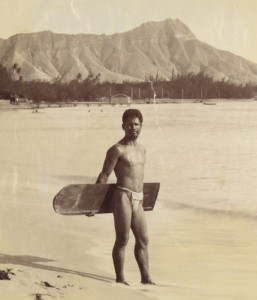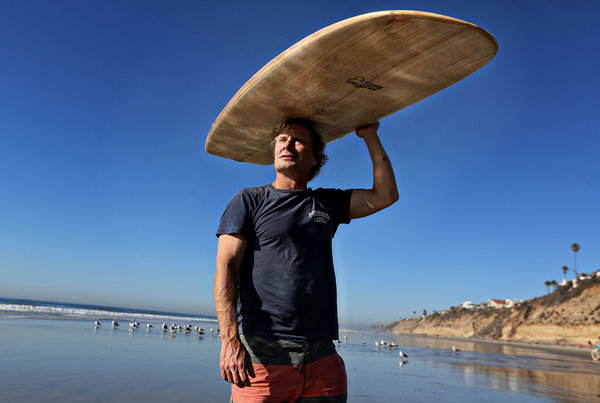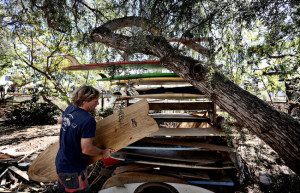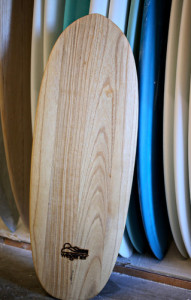VIA – NY TIMES
Jon Wegener with his surfboard at Moonlight Beach in Encinitas, Calif.
By CLAIRE MARTIN
Published: December 21, 2013
In 2008, Dan Malloy, a professional surfer, received a package in the mail from Australia. In it was a thin, rectangular slab of wood with one rounded edge. It was a board like none he had ever seen, remarkable for being so slender and for lacking contours or fins.Frank Davey/Bishop Museum

Jon and his brother Tom have looked to old Hawaiian wooden designs to innovate in a sport that had become more reliant on factory production and synthetic materials.
Mr. Malloy, then living in Lompoc, Calif., took the board to a nearby surf break. He propelled himself into a wave, stood and then panicked. “I thought, ‘Oh, this wave is way too fast for me, and there’s no chance I can make it,’ ” said Mr. Malloy, who has surfed for decades. But he did make it, and soon was gliding effortlessly through the water — and really fast.
Mr. Malloy was riding a board called an alaia (pronounced ah-LIE-ah), descended from the original Hawaiian surfboards. He would begin riding its smaller but equally fast counterpart, the paipo (pronounced PIPE-oh), a year later.
Sandy Huffaker for The New York Times
Jon Wegener removed a surfboard from a rack near his home.
Both types of surfboards are made by Tom Wegener, an American living in Australia, and his brother, Jon, who is based in Encinitas, Calif. The brothers grew up surfing in Palos Verdes, Calif., and began shaping regular foam and fiberglass surfboards as a hobby when they were teenagers, and then professionally after college. They now operate separate businesses, Tom Wegener Surfboards and Wegener Surfboards, but they often share ideas and collaborate on designs.
In recent years, they have revived Hawaiian surfboard designs to innovate in a sport that had become increasingly reliant on factory production and on synthetic materials like foam and fiberglass. While resurrecting ancient innovation is not a new practice, “it tends to be very rare,” said Joel Mokyr, a professor of economics and history at Northwestern University. But he said some innovators, inspired by nostalgia and the belief that the wisdom of the past can trump what we know today, decide to look back in time.
Tom Wegener started making alaias after visiting the Bernice Pauahi Bishop Museum in Honolulu in 2004 and measuring traditional boards dating to the late 1800s and early 1900s. Captivated by their simplicity, he began creating his own versions using a lightweight, naturally water-resistant wood called paulownia.
In 2006, Jon Wegener visited his brother in Australia and saw the new designs. Almost on the spot, Jon began shaping alaias of his own. “You see something like that and you freak out,” he said. “You just want to instantly shape one.” And so the two began collaborating informally on designs.
After returning to California, Jon continued making alaias, and from 2008 to 2010 they grew to be roughly 80 percent of his business. Regular foam-and-fiberglass boards, which he had been shaping and selling for 15 years, made up the rest. Customers for the alaias included well-known professional surfers like Mr. Malloy and Rob Machado. The boards even landed roles in several surfing movies.
Sandy Huffaker for The New York Times
Unlike regular surfboards the wooden boards can be refined and improved throughout their life span using simple tools like handsaws and sandpaper.
But there was a problem: Non-elite surfers found alaias hard to ride because they don’t float as well as modern boards. As the Wegeners experimented with different designs, they realized that the more diminutive paipo was easier to ride. It was also more fun, partly because it performs well in small waves. “Big waves are cool; small waves aren’t,” Jon Wegener said. “But small waves are what you have 90 percent of the time.”
The paipo ranges in length from three to five feet; some models are as slender as a half-inch thick. This allows riders to tuck into a wave’s sweet spot, he said, what surfers call the pocket.
Because the exact shapes of waves vary, the Wegeners have created various paipo designs for different types of surf, a common practice among modern surfboard shapers.
Unlike regular surfboards, which are a finished product by the time they first hit the water, the wooden boards can be refined and improved throughout their life span using simple tools like handsaws and sandpaper. They are also relatively impervious to dings and dents.
While demand for alaias has begun to decline because of their difficulty, paipo sales have increased, Jon Wegener said. He sells his boards through his website and Nalu Dry Goods, in Bay Shore, N.Y., and a handful of Southern California surf shops. The Patagonia store in Cardiff-by-the-Sea, Calif., north of San Diego, sells his paipos for $325 each.
Paipos also are made in South Africa, where designers at Wawa Wooden Surfboards shape them, and in Brazil, where Lasca Surfboards produces them. In Japan, Nobbywood Surfboards makes rectangular designs resembling kitchen cutting boards. The United States market also includes Grain Surfboards in Maine and several other shapers in California.
“It’s starting to get more traction for sure,” Roy Coffman, manager of the Cardiff Patagonia store, said of the paipo. Still, he considers it a niche product and sales remain modest, about 15 boards in the last year.
The main challenge is that the paipo is essentially an ancient boogie board — and in surfing circles, boogie boards are not considered cool. This stigma is a hurdle, but attitudes could be starting to change, Jon Wegener said.
He recently embarked on a new set of designs using both paulownia wood and foam. The boards are flat, like those of the traditional designs, but more buoyant — having the best qualities of each style of board.
“What’s so great about this wood movement is it’s a whole new book,” he said. “A whole new chapter for surfing.”
A version of this article appears in print on December 22, 2013, on page BU3 of the New York edition with the headline: Catching a Wave That Started in Old Hawaii.
Original source:
 Become A Sponsor!
Become A Sponsor!If you have a product or service that is a good fit for our surf community, we have opportunities for you to sponsor this blog! Download our media kit now!



